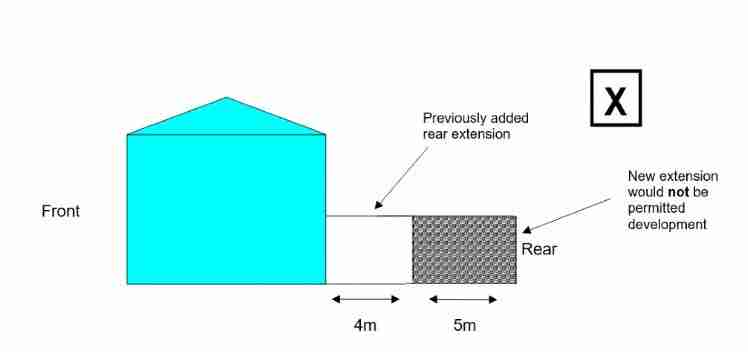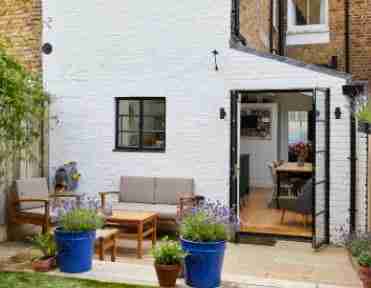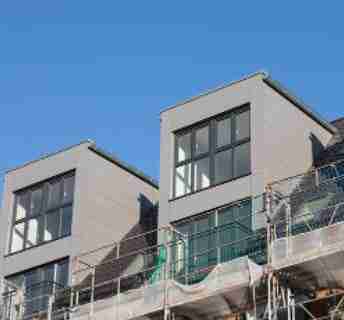The new Permitted Development strategy announced in August 2020 means that planning permission is no longer needed for alterations and extensions to some properties. If you’re a landlord or leaseholder considering property development, LMP Law offers a comprehensive property development guide to navigate the realm of permitted development for residential properties.
When it comes to landlords or developers (or RTM and Collective Enfranchisement) owning or managing blocks of flats (with the allowance of adding up to two stories on top of the building), following the permitted development guide can mean the time, energy, money, and paperwork of getting planning permission is eased.
Permitted Development is perfect for those looking to add some extra living space to the property as long as they meet the guidelines!
It’s never as simple as it seems, is it?
If you are looking for what you can do with Permitted Development, and what permission you will need then keep on reading as all of the information will be provided in this property development guide article! Or just get in touch with one of our team if you’re thinking of going down this route, either on your house or as a landlord or developer on a block of flats. Laura and the team – at your service!
WHAT TYPE OF WORK CAN YOU CARRY OUT WITH PERMITTED DEVELOPMENT?
It’s super important to understand where and what you can build on without going through the rigmarole of planning permission. Here are some permitted development guide or property development guide examples:
PERMITTED DEVELOPMENT FOR HOUSE AND HOME EXTENSIONS
You can build an extension! Within reason! If you are thinking of buying a property with a view to selling on for a profit, or if you live in a home and fancy more room, extensions are perfect. However, never just built and assume it’s ok for council’s planning department. Do follow the guidelines carefully, because it depends if you own a terraced house for example, rather than a detached, or even more tricky a listed property.
REAR EXTENSIONS AND PERMITTED DEVELOPMENTS
You can add up to eight metres onto the back of the property with a single storey extension or up to six metres with a double extension. There are some restrictions around the height and rear which you need to be aware of.
You will need to make sure that the extension doesn’t cover more than half of the garden or goes beyond the point of the original building line at the front of the property, so check those deeds! The materials that you build with must be the same, or as similar, as possible to the existing property as part of the permitted development guide or property development guide.
I’m not going to lie; it gets quite technical if your house has previous extensions and what you can or can’t do. The Government portal has nice visuals with example measurements to guide you, but if you have an architect working with you, then they should know this!


SIDE EXTENSIONS AND PERMITTED DEVELOPMENTS
If the proposed work is a side extension, then these are allowed too under Permitted Development, however, they are subject to height and width restrictions, as you would imagine. There are clear rules to help you find out if your side extension qualifies for permitted development guide, these limit the height and width as well as distance from the boundaries.
There are different rules for different circumstances in the property development guide, e.g., if you live in a conservation area, or if you have a listed building, are end of terrace or even mid terraced.
If you are looking at proposals with these points below in mind you will NOT be allowed to build via Permitted Development:
Your side extension will not qualify for permitted development guide if:
- It is more than half the width of the original house
- the roof on your proposed extension is higher than the highest part of the existing roof, or higher at the eaves than the existing eaves – check this point because it might not be a problem, unless you are planning a double-storey side extension OR the original building is a bungalow.
- it is going to be taller than three metres and come within two metres of the boundary of your existing property
- your side extension includes any raised platforms, verandas, microwave antenna, flue, soil or vent pipe, chimneys or a balcony
- you want to change the original roof of the building
- you want to use a different sort of material on the outside of the building (because everything should match as mentioned above under rear extensions).
If you have a detached house, the side extension must not extend more than four metres to the rear from your original house.
If you have a semi-detached or terraced house, it must not extend for more than three metres to the rear from your original house.

As a reminder for the property development guide, a single-storey side extension cannot be taller than four metres to qualify for permitted development.
Size really does matter!
If you want to have something bigger then you can still make these plans, they’ll just be reviewed by the planning department of your local authority instead, and it will be up to their discretion to decide if you’re allowed to go ahead.
LOFT CONVERSIONS AND PERMITTED DEVELOPMENTS
Converting the loft into a space to live, such as a bedroom or games room is covered by Permitted Development guide. Because of this, the roof can be extended up to forty metres cubed for terraces, or fifty metres cubed for semi-detached homes, as well as detached properties.
Adding windows to the roof is an essential part of converting it into a living area but be careful in that dormers and roof windows must not extend beyond the plane of the roof slope located at the front of the house!
In this property development guide, windows and lighting are often in the issue in the loft space plans! Think carefully when it comes to choosing the light just in case your choice falls outside the parameters of Permitted Development and into Planning Permission.
When it comes to the nitty gritty for going up, then there are quite a few restrictions.
If you are sitting in your period Victorian terrace house or your 1920s semi dreaming of conversions above your head, sadly you cannot build without going through planning permission because the law states that houses built before 1 July 1948 or after 28 October 2018 (for extending homes) or 5 March 2018 (for adding new flats) cannot be extended upwards without planning permission.
It doesn’t mean you can’t apply; it just means you can’t build via Permitted Development.
HOW THE PERMITTED DEVELOPMENT RIGHTS FOR EXTENDING HOUSES UPWARDS WORK
The new Permitted Development Rights (PDR) for upward extensions mean that the following types of building can add a maximum of two storeys to create housing space without planning permission:
- Detached, purpose-built blocks
- Houses (if the new storeys are to extend a home)
- If you live in a terrace, you can only go 3.5 metres above the rest of the terrace.
- If you live in a semi-detached house, you can go 3.5 metres higher than the house with which you share a party wall.
- Detached houses (to build new flats)
- If you live in a detached house that’s two or more storeys high, you can add two storeys.
- If you live in a bungalow, you can only add one storey, and for all houses, the roof type must match what you have right now.
- Terraced/semi-detached (to build new flats) – see above under Houses.
We are only writing about residential living in this post, but of course, commercial buildings have their own permitted development guide too!
BUILDING A PORCH AND PERMITTED DEVELOPMENT
Porches are so handy, aren’t they? Whether it’s for a buggy, wheelchair or just extra space, they are often a simple and practical build. To keep in with the PDR, make sure that the porch design doesn’t fall within 2 metres of the boundary of the original property and the highway.
And, in this property development guide, you should also be aware that the external property must not be more than three metre squared and is no higher than three metres above ground level.
You need might need permission if you live in a listed building, designated area or fall under an Article 4 Direction*
* Article 4 Directions are made when the character of an area of written importance could be threatened with certain builds or extensions. They are mostly found in conservation areas or areas of historic value. The best way to check if your property has an Article 4 aligned to it by checking with your local planning authority if you are not sure.
Plumbing is another issue too – i.e., if you’d like to add a toilet within the porch area, then this might not be as cut and dry and you might think when it comes to planning.
BUILDING A GARDEN OFFICE – PERMITTED DEVELOPMENT | PROPERTY DEVELOPMENT GUIDE
Surprisingly, some innocuous garden builds such as a greenhouse, shed or garden office, might need planning permission! Owing to Covid19 and #workingfromhome the rise in home extensions and garden office builds has increased twofold.
So, if you’re having thoughts of a fancy log cabin, a pretty garden summerhouse, an insulated home office (the new ‘man cave or she shed’!), a child’s playhouse, or a good old fashion shed, your garden design may well be subject to planning regulations.
To keep them in the Permitted Development guide or less, then any outbuildings you’re proposing to build must not be any higher than a single storey and they aren’t allowed to cover more than half the area of land around the property.
It is important to note that if you fancy a balcony, veranda, or raised platform then these do not fall under the PDR unfortunately or property development guide.
If you live in any of these below, then you may well need Planning Permission, so do check with your local authority:
- conservation area
- area of outstanding natural beauty
- by a or on the grounds of a national park
- Norfolk broads
- world heritage site
- listed building
There are other development rules and planning laws that may affect where your outdoor building can be placed, here’s a quick run-down:
- Your building must be placed at least 2 metres away from your “dwelling house” boundary.
- The building cannot be used as living accommodation. This includes sleeping accommodation or as a place for someone to live. Sadly, there are unscrupulous landlords subletting to desperate or vulnerable tenants, but we hope to see a crackdown on this.
- You cannot place your outdoor building in the front of your property.
- The building must take up less than 50% of your grounds around your main building. ALSO, many of our homes have already been extended either by ourselves or my previous owners, if so, then the 50% comes from where the main building stood as at July 1st 1948.

ADDING WINDOWS & DOORS AND PERMITTED DEVELOPMENT RIGHTS
Inserting new windows and doors, skylights, or roof lights is key to so many of our desired extensions.
Dormer windows are usually classed as Permitted Development the same as roof windows and skylights. So, you won’t need planning permission for dormer windows unless they exceed certain measurements or if you live in a listed building or conservation area.
Worth checking with your architect and building, because if you change the design or window requirement in the middle off a build, you might just find yourself requiring (and therefore waiting!) for Planning Permission.
In general terms, you do not usually need to apply for planning permission for insertion of new windows and doors that are of a similar appearance to those used in the construction of the house.
PERMITTED DEVELOPMENT RIGHTS AND BLOCKS OF FLATS
Upward extensions of blocks of flats are often contentious owing to skyline issues and existing tenants or councilors’ concerns, however landlords and developers have a 2022 update on adding 2 Storeys to their property without planning permission, so it’s about communication from the start.
Permitted Development allows existing buildings to be extended upwards as long as they are detached, purpose-built blocks of flats. There are no rules in place regarding the previous use of the building, so previous houses, offices, or anything else can benefit from Permitted Development.
The Government is under pressure to fulfil the need for living space and with the talk surrounding tenants being allowed to buy their housing association flats it seems mad not to take advantage for developers and landlords to build up for new housing requirements, including local authority blocks too.
There is a genuine UK housing crisis in the UK and restarting the economy after the COVID-19 shutdown means a better blend of leasehold law, residential living and requirement for less red tape in line with the new Building Safety Act 2022.
With most things though, there are some guidelines that need to be met.
- The block must have been built after 1st of July 1948 and before the 5th of July 2018. It also needs to be at least three stories high but no more than 30m once the extension has been completed.
- This new right does not apply to properties that are in an Area of Outstanding Natural Beauty or areas that already have restrictions in place for building. Such as, places of specific scientific interest, world heritage sites, safety hazard areas, and military explosives storage area. So, it is important to check if the block of flats is in an area like this before submitting your proposed work.
- When proposing the extension to the block of flats keep in mind that the new flooring should not extend beyond the front or the side of the existing blocks of flats and they also should not go beyond the boundaries of the plot.
Any development must take into consideration the following factors.
- Telecoms and their masts
- Health & safety
- Rights of light
- Insurance
- Residential Tenants’ right of first refusal
- Party WallsCollective Enfranchisement
Read HERE for DEVELOPERS on airspace builds and Permitted Development Rights.
EXISTING BLOCKS OF FLATS AND PERMITTED DEVELOPMENT
If you’re the landlord of a block of flats then know that your extension or build differs greatly from a house’s permitted development rights!
UPWARD EXTENSIONS TO BLOCKS OF FLATS IN AN EXISTING BUILD, USING PERMITTED DEVELOPMENT RIGHTS
Since the 2020 Government’s new permitted development rights allowing existing buildings to be extended upwards in reply to the consultation surrounding housing crisis, landlords of existing blocks of flats have been able to work with architects to build up into the airspace without having to go through planning permission.
However, this rule only applies to detached, purpose-built blocks of flats. Flats that were borne of conversions, whether they were previously houses or offices, cannot benefit from the new airspace PDR.
To be more precise, existing blocks of flats can extend upwards using PDR as follows:
- If they are purpose-built detached block of flats (yep, not a conversion)
- If they were built between 1st July 1948 to 5th March 2018
- If they are least 3 storeys high as existing
- If they are no taller than 30m once extended
There are various other factors such as where the block of flats is, and will that location have the Article 4 used, by this we mean the local authorities could block the rooftop creation if the property is located in “area of outstanding natural beauty”, a conservation area, site of special scientific interest, Norfolk Broads, any National Park, World Heritage Site; as well as if it’s in an area of safety hazard, in a military explosives storage area (you’d be surprised….did you know how much land the MOD own?!), or land within 3km of an airfield. That said, the majority of urban airspace designs proposed are urban, owing the need for the populous to have use of resi living!
If the new upper storeys are built under the provision of a PDR, then other works are permitted of course (such as plumbing, wiring or strengthening foundations or walls) but only for the purpose of making these new storeys.
What must the new extended storeys have as part of their build?
Have internal floor to ceiling heights not exceeding three metres, only be a maximum of 2 storeys; and not exceed seven metres above the existing building.
If you are a landlord, it is worth digging deep into the area of your property and also undertake research into questions that the local authority will no doubt, ask of the proposed airspace extension, and the impact it would have on, say:
- Local traffic
- Protected views
- If there could be any contamination risks
- Neighbouring privacy and / light interference
- Design of the external build
- If there will be enough natural light in new flats
- Any flood risk issues
It might seem a given, but just in case, residents and occupants of the property (as well as adjoining property occupants and owners), must be notified and consulted of this so they are able to have the opportunity to comment on the proposed works.
THE IMPACT ON EXISTING LEASEHOLDERS WITH AIRSPACE EXTENSION PROPOSALS
It would come as no surprise that residents of a block of flats hearing of new, substantial works on their building may not go down well. How you deal with this is one that must be handled correctly, and if you can have that open dialogue and possibly add any sweeteners along the way is key.
Ultimately the owner of the building has a right to develop it unless there are very specific restrictions on development, yet at the same time the tenant’s right to “quiet enjoyment” cannot be used as an argument to prevent the development taking place. The case of Goldmile Properties Ltd v Lechouritis [2003] was a Court of Appeal case where a tenant ran the quiet enjoyment argument and lost.
Construction working with the landlord and developers should be mindful and considerate with their hours of working, the length of time the development takes and even the location of scaffolding to ensure the residents aren’t given a justifiable opportunity to challenge the airspace development.
How to work with leaseholders when proposing airspace development on your block of flats? Depending on your communication, service charges could be kept in the same regime, whilst perhaps explaining to them that their property will have value added to it owing to a newly refurbished exterior, as well as refurbished communal areas including lifts and staircases and of course a new roof. This takes away the anxiety and fear of major works or added service charges which are often already a cause of dispute.
Make sure that your legal advisor has these new arrangements documented and evidenced, noting who the party responsible for the maintenance and repair of communal areas (which could be the freeholder, management company or the tenants themselves if Collective Enfranchisement or RTM).
Other incentives to work effectively with existing leaseholders could be to may offer to extend their lease, or enable them to partake in shares. If the push back comes from adjoining neighbours and their concerns surrounding party wall legislation, rights of light or restrictive covenants, ensure the dialogue is transparent and open and manage this with your legal advisors early in the stages and always document the agreements.

If you live and own a property in a block of flats and would like to refurbish your property the first thing you need to do is to check your lease. As a leaseholder, you won’t require planning permission or permitted development (in the main), but don’t forget there are rights within your lease you must adhere to before you start knocking down walls!
As you can see, Permitted Development doesn’t apply to you as a leaseholder, but you still need to be aware of what you can and can’t do in your own flat.
LEASEHOLDERS’ FLAT REFURBISHMENTS – DOS AND DON’TS
Your lease will hold all of the important information and legal rights and responsibilities that you have for that property. Pay close attention to any clauses about refurbishments and alterations that can be carried out on the property as these should give you a great heads up on what you can and can’t do.
Every lease is different so make sure to check yours!
Most alterations require the consent of the landlord so don’t start work before speaking to them as this could mean that you are breaching your lease! This information will be in your lease so double check everything!
Freeholder’s written consent to proposed work that alters the leasehold property is provided by a Licence to Alter. This typically is drafted by solicitors which is in place to protect the freeholders against any losses and to ensure that the work being carried out won’t affect other residents in the property.
You only need the Licence to Alter (LTA) for work such as:
- Removal of chimney breast, loadbearing wall
- Creating new openings within a wall
- Changing any windows or glazing
- Moving the bathrooms or kitchens
- Installing new heating systems
- Altering floor finishes such as going from carpet to hard floor
The application for the job proposal needs to be sent along with detailed plans and specifications that the landlord’s surveyor can review. Take note that a freeholder by law has to accept your LTA application as long as reasonable conditions have been met and the interests of everyone involved and affected by the jobs are protected. In law the “reasonable” is often the keyword and the evidence of showing fairness is the norm.
DON’T FORGET!
Permitted Development Rights do not remove requirements for permissions or consents under other regimes such as the Building Regulations and the Party Wall Act.
You will need prior approval from your council to use any of the new permitted development rights including extension of houses upwards.
If you love reading the legislation of the Act – here you go! Town and Country Planning (General Permitted Development) (England) Order 2015 (“the Order”) as amended.
Any questions or need legal guidance and professional advice regarding any of the issues in this blog, do shout! Here’s our contact page, or just email us: enquiries@lmp-law.com
Laura
x





